(Some images are in Thumbnail format, so please click on them for the full screen version)
Welcome to the Racing and Rare Sno*Jets section. You'll find information on some of the rarest Sno*Jets, lots of information on the racing history and all the different race sleds available.
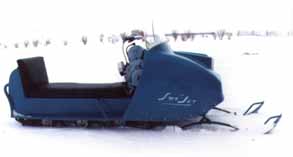 We'll start with probably one of the rarest Sno*Jets ever. There isn't a whole lot of information on this actual sled. It is either a 64 Prototype, or a 1965 production model, where only 25-50 were produced. This
is one of three known to still exist today. The actual sled pictured was restored by John Livingstone, the western distributor for Sno*Jet back in the 70's. John is a good friend on mine, and has been a great help with this page. John is actually pictured below with Al and Bobby Unser on their 71 Tjets. I also managed to track down a memo from John when he was actually searching for a 64 or 65 Sno*Jet. And the sled pictured is the one he found and restored. He also got most of the parts for the restoration direct from the factory.
We'll start with probably one of the rarest Sno*Jets ever. There isn't a whole lot of information on this actual sled. It is either a 64 Prototype, or a 1965 production model, where only 25-50 were produced. This
is one of three known to still exist today. The actual sled pictured was restored by John Livingstone, the western distributor for Sno*Jet back in the 70's. John is a good friend on mine, and has been a great help with this page. John is actually pictured below with Al and Bobby Unser on their 71 Tjets. I also managed to track down a memo from John when he was actually searching for a 64 or 65 Sno*Jet. And the sled pictured is the one he found and restored. He also got most of the parts for the restoration direct from the factory.
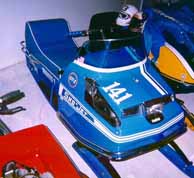
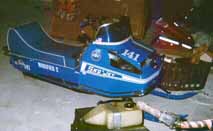
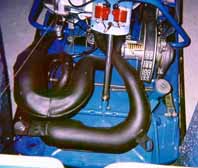
Next on the list is the 1970 Sno*Jet GT. It was Sno*Jets first real attempt at the racing circuit. There were three different versions. The GT1 was the smaller sled, had a few different motors available, but were all singles (either hirth or sachs). Pictured above is the GT2, once owned by Jerry McGee. The GT2 came with the 338 right up to the 634. Motors were either a Yamaha or Hirth twin. Then there was the GT3, a very limited production sled. The one pictured below belongs to David Schark, and is in original condition. It is one of about 4 still known to exist today. It came with the 793 hirth honker, and had a stock exhaust setup, or the optional triple pipes. The sled was also a widetrack to support that amount of power and the actual width of the motor.
As far as production numbers, there were roughly 250 GT1's, 200 GT2's, and 10 or 11 GT3's.
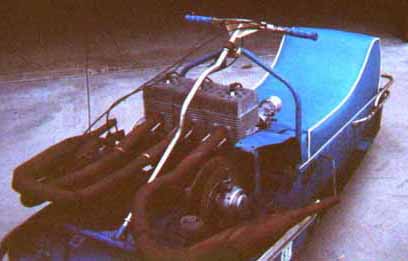
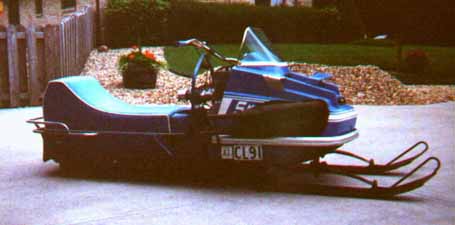
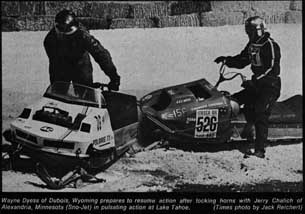
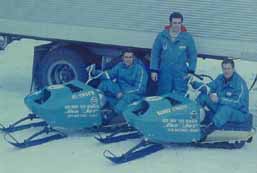
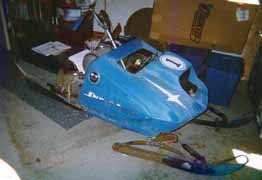
Now I know you all saw this coming, because this is the sled that brought Sno*Jet into direct competition with all the big boys. The ThunderJet! Click here for a complete history on the Thunder Jet. The Thunderjet was first designed by Duane Aho and Jim Adema. Now the first year wasn't the most
sucessful, they still had some bugs to work out, but the sled showed that their was hope. They tried to adapt the changes to the GT but ended up just keeping the tjet. The sled was a real start for radical designs, exotic metals and technologies. Also pictured above is Al and Bobby Unser on their 71 Tjets. If your wondering who that other guy there is, well, its John Livingstone, mentioned above with the 1964 Sno*Jet. Beside that picture is Al Unsers sled today. Jerry McGee tracked it down, and the sled is currently up for restoration.
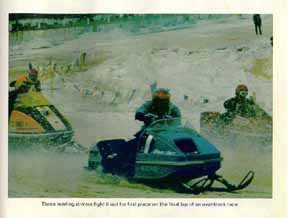 Our next sled on the list is the 1972 Sno*Jet SST. Now the sled isn't all that rare, because it was a production model, but still, for stock racing the sled did quite well and also had potential for modified racing, on both the oval and for cross country. With the SST, they introduced the multiflex slide suspension, which Sno*Jet used till 77, just making changes year after year. The SST sort of came after the 71 SS Jet, and just became more popular year
after year. With the SST, it was also the first sign of the takeover of yamaha motors over the older and heavier Hirth motors. They kept
developing the yamaha motors and they worked great for the stock trail application, another one of the reasons why the SST did so well. Now over the next two years, the SST didn't change that much, other than minor tweaks to the suspension, and minor changes to the seat, hood and gas tank. There were
many aftermarket parts available, stuff like Hooker Headers and so on. When 74 came around, the SST was quite a beauty, and they squeezed about 45 hp out of that basic yamaha motor.
Our next sled on the list is the 1972 Sno*Jet SST. Now the sled isn't all that rare, because it was a production model, but still, for stock racing the sled did quite well and also had potential for modified racing, on both the oval and for cross country. With the SST, they introduced the multiflex slide suspension, which Sno*Jet used till 77, just making changes year after year. The SST sort of came after the 71 SS Jet, and just became more popular year
after year. With the SST, it was also the first sign of the takeover of yamaha motors over the older and heavier Hirth motors. They kept
developing the yamaha motors and they worked great for the stock trail application, another one of the reasons why the SST did so well. Now over the next two years, the SST didn't change that much, other than minor tweaks to the suspension, and minor changes to the seat, hood and gas tank. There were
many aftermarket parts available, stuff like Hooker Headers and so on. When 74 came around, the SST was quite a beauty, and they squeezed about 45 hp out of that basic yamaha motor.
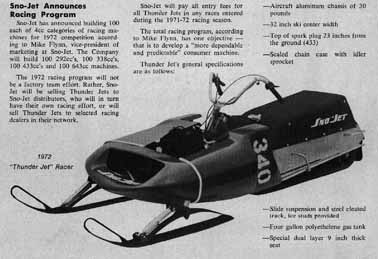
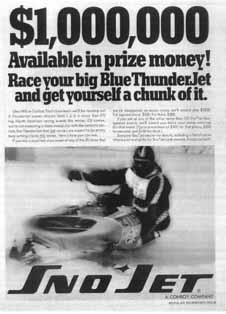
The 1972 Thunder Jet
took over the racing circuit. There were only one hundred available for each of the 4 motor options, so they are extremely rare, and are still even today very
competitive. The sled had one objective, to make a more dependable and predictable consumer machine. The sled featured
an aircraft alluminum tunnel, and was very low and wide. It was testing grounds for the stock machines, trying out the new technologies like disc brakes and lightweight alluminum. The motor was more offset than the competitors and worked out quite well in oval racing. Now Sno*Jet never really had a factory racing team, instead they just sold off the thunderjets and actually paid all the entrance fees for every race entered. That turned into the Sno*Jet Million Dollar Racing Incentive Program. Where with every race entered, if you placed, Sno*Jet would turn around and pay out the racer. So that really helped and
gave all Tjets owners another reason to race. The sled did great and a lot of people turned to the thunderjets in 73 where it basically beat out every other manufacturer, and no other sled company has been able to do that since...
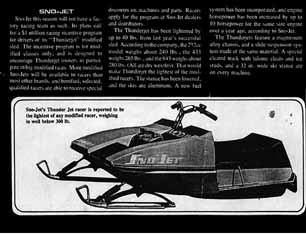

Now in 1973, they just made more improvements to the 72 Tjet. The sled now weighed under
300 lbs. They had the Million Dollar Racing Incentive Program, as well as special discounts on all parts for racers. The factory made all the information available so your average racer had all the help available to keep their sleds up to date. Unfortunaly, 1973 was the last year Sno*Jet made a fire-breathing modified racer.
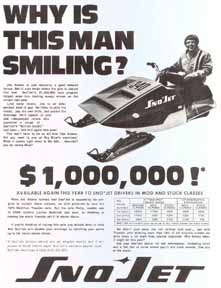
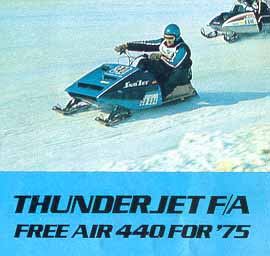

For 1974 and 1975, the ThunderJet took on a different look. The sled design was still improving, but the sled turned into a stock racer. They had some problems in 1974 with the USSA and the production quantity rule, so for 1975, they had to build
more sleds. So that means the 74/75 isn't quite as rare as the 71/72/73 mods, but are still highly sought after. The sleds did quite well with the F/A yamaha motors. One thing that did help them was the GYT Kit (Genuine Yamaha
Technology). It contained everything you needed to get the fire-breathing mod back into your sled, consisted of pipes, cylinders, heads and made the sled quite competitive again. So you could go out and buy a 74 or 75 thunderjet, and the sled would be an amazing stock trail sled, but you also had the option
to go full out and race it. Unfortunatly with the Sno*Jet name being sold to Kawasaki, 1975 was the last year of the thunderjet, and Jim Adema then went and raced for Yamaha. No sled would ever come close to dominating the circuit and the heart of millions like the ThunderJet.
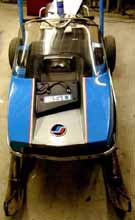 In 1974, Sno*Jet produced a sled called the Sabre Jet. The sled was built using the design and technology from the success of the ThunderJet. Sled was pretty good looking, had a wide stance, powerful reed valve motor, and a shiny chrome top sticking out of the hood. The sled did quite well, but there were many of them produced, being a stock trail performance sled. Then mid season Sno*Jet surprised everyone with a special Sabre Jet. The 650! It was very similar to the 440 F/C sled, but this one featured a 650 Hirth F/C, so the sled had quite a bit more power and apperently drove circles around the 440. Besides the motor, the only other noticeable difference was the center of the hood, the 440 being black with the chrome motor, the 650 had a black motor with a silver center to the hood. The sled pictured above belongs to Todd Koehn, he picked it up from an old dealer and the sled is actually completely original. Now this sled is rare, there were only around 281 of them built, and I have recently started a registry for the 650's. Click here to take a look at the registry. A lot of people are on the lookout just for a regular Sabre Jet, so
next time you see one, be sure to check out the motor, you may be in for a big surprise!
In 1974, Sno*Jet produced a sled called the Sabre Jet. The sled was built using the design and technology from the success of the ThunderJet. Sled was pretty good looking, had a wide stance, powerful reed valve motor, and a shiny chrome top sticking out of the hood. The sled did quite well, but there were many of them produced, being a stock trail performance sled. Then mid season Sno*Jet surprised everyone with a special Sabre Jet. The 650! It was very similar to the 440 F/C sled, but this one featured a 650 Hirth F/C, so the sled had quite a bit more power and apperently drove circles around the 440. Besides the motor, the only other noticeable difference was the center of the hood, the 440 being black with the chrome motor, the 650 had a black motor with a silver center to the hood. The sled pictured above belongs to Todd Koehn, he picked it up from an old dealer and the sled is actually completely original. Now this sled is rare, there were only around 281 of them built, and I have recently started a registry for the 650's. Click here to take a look at the registry. A lot of people are on the lookout just for a regular Sabre Jet, so
next time you see one, be sure to check out the motor, you may be in for a big surprise!

In 1974, Sno*Jet actually released an early version of the 1975 SST. It was known as the SST Presidential. It was sent out to members of the Presidential Council, and was basically used for feedback on the sled. If you compare a 74 SST to a 75 SST, they are completely different. This was a huge step for Sno*Jet so be releasing an early version, they could make changes if required prior to the production version of a 1975 SST actually going to the market. There wasn't great feedback on the red colors, and plain decaling, so they changed it to a blue stripe and put on different decals on the side of the hood. There are a few other small differences between the presidential SST's and the productions SST's. If you check the 1975 Sno*Jet brochure, you'll notice they all have the red stripes and earlier style decals. There is actually a whole lot more to the story of the Presidential SST's, its actually still being uncovered, and I'll be putting out an update very soon.
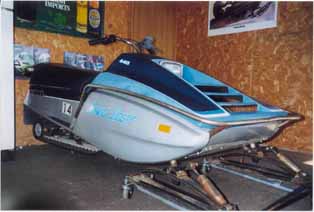 Now for a Sno*Jet factory prototype. This one is called the Phantom Jet, we do not know a whole lot about the sled, but have been uncovering new details recently.If you look at the sled, its completely different than anything Sno*Jet, or any other manufacturer had ever put together. The Phantom Jet actually came from the Thunder Jet II prototypes (click here for full details). It was originally conceived to follow up the 72/73 Thunder Jets. The sled was built with a monocoque frame, and was incredibly light. The idea was to leapfrog all the competition and current technology. With a lot of the testing being done on the track, the sled could also be developped into a production sled. To keep the sled safe, it was given a bumper, and hood to cover all the moving parts. The factory only built a handful of them, and it seems like the prototype Phantom Jet's were actually built on the Thunder Jet II prototypes. We believe they would have been shipped to distributors and a couple dealers. There could have been more built, and they very well could have been destroyed.
Now for a Sno*Jet factory prototype. This one is called the Phantom Jet, we do not know a whole lot about the sled, but have been uncovering new details recently.If you look at the sled, its completely different than anything Sno*Jet, or any other manufacturer had ever put together. The Phantom Jet actually came from the Thunder Jet II prototypes (click here for full details). It was originally conceived to follow up the 72/73 Thunder Jets. The sled was built with a monocoque frame, and was incredibly light. The idea was to leapfrog all the competition and current technology. With a lot of the testing being done on the track, the sled could also be developped into a production sled. To keep the sled safe, it was given a bumper, and hood to cover all the moving parts. The factory only built a handful of them, and it seems like the prototype Phantom Jet's were actually built on the Thunder Jet II prototypes. We believe they would have been shipped to distributors and a couple dealers. There could have been more built, and they very well could have been destroyed.
This particular sled belongs to Jay Carsley of Cove Side Wheel and Ski. The sled would have been built around 73/74, and if it would have gone into production, it would have been for the 1975 season. The sled features a 440 F/C yamaha motor (different motors were being tested), with a single mikuni carburator, multiflex 75 track and suspension.
We're not really sure why it never made it to production. It could have been because the monocoque chassis design needed a bit more re-inforcing, and the president of Sno*Jet at the time didn't want to take the risk, or maybe something to do without the Kawasaki buyout coming down the road.
I asked John Livingstone about it, and he remembers going to the factory to test the sled out, and actually has the parts manual for it, cause the sled was supposed to be produced, but never made it. So this sled is pretty darn rare, there are only 3 known to exist at this point in time.
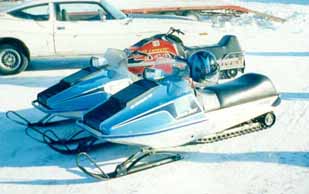
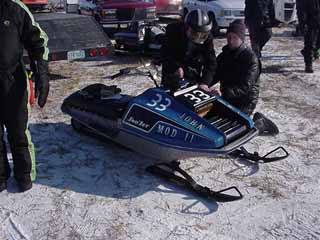
In 1975, Sno*Jet completely changed their lineup. They had great success with the SST from 72-74, so they brought it one step higher. Using some of the technology from the ThunderJets, they basically started from scratch to redo their most popular stock machine. They used an alluminum tunnel, the new multiflex 75 slide suspension and track system. The motor was mounted lower in the bellypan with a wide stance. The suspension was great, there is close to 8 inches of travel, and it actually took arctic cat till the late 80's to even match the 75/76 Sno*Jet suspension. Those sleds ride great, and power wise, they used the yamaha motors. The sled was available with a 340 and 440 yamaha motor. The 440 F/C had reed valves, and had quite a bit of power. For 1976, all they really did was change the carburation from Keihin to Mikuni on the F/C models again, and they gained even more power. The great thing about these sleds was that in 1975,
there were a few different versions available, you could get the F/C's, but there was also the option for the Free Air Yamaha motors. Basically the exact same motor, carbs, and exhaust as the 75 Thunder Jets.
The biggest difference was that the SST F/A was quite a bit heavier than the Tjets, as it was designed for more abuse on the trails. The 440 F/A boasted a very high 65 hp. Then you could also get the GYT Kit for the sled, and basically turn your F/A trail sled into a mod. Pictured above is two 1975 SST 440 F/A's, one belongs to Blake Read, and the other to Joe Kautz. Then beside that picture shows a bit of the potential available to the stock sled. John Schmitt's 1975 SST 340 F/A mod is shown, the sled is stripped down a bit to reduce weight, but has been ported, polished, has the carbs and pipes, and boy does that thing ever scream.
The sled did quite well, and even though it is a stock sled and there were a decent amount produced, they're getting harder to find. The F/A's seem be more sought after than the F/C's, but they're all still right up there on a collectors list. The 340 F/A is probably the rarest of them all, as there were 3 actual different versions of the 440 F/A. Click here for a few more details on the development of the SST F/A.
So keep and eye out, if you find any of the sleds pictured in this section, its probably worth while picking it up.